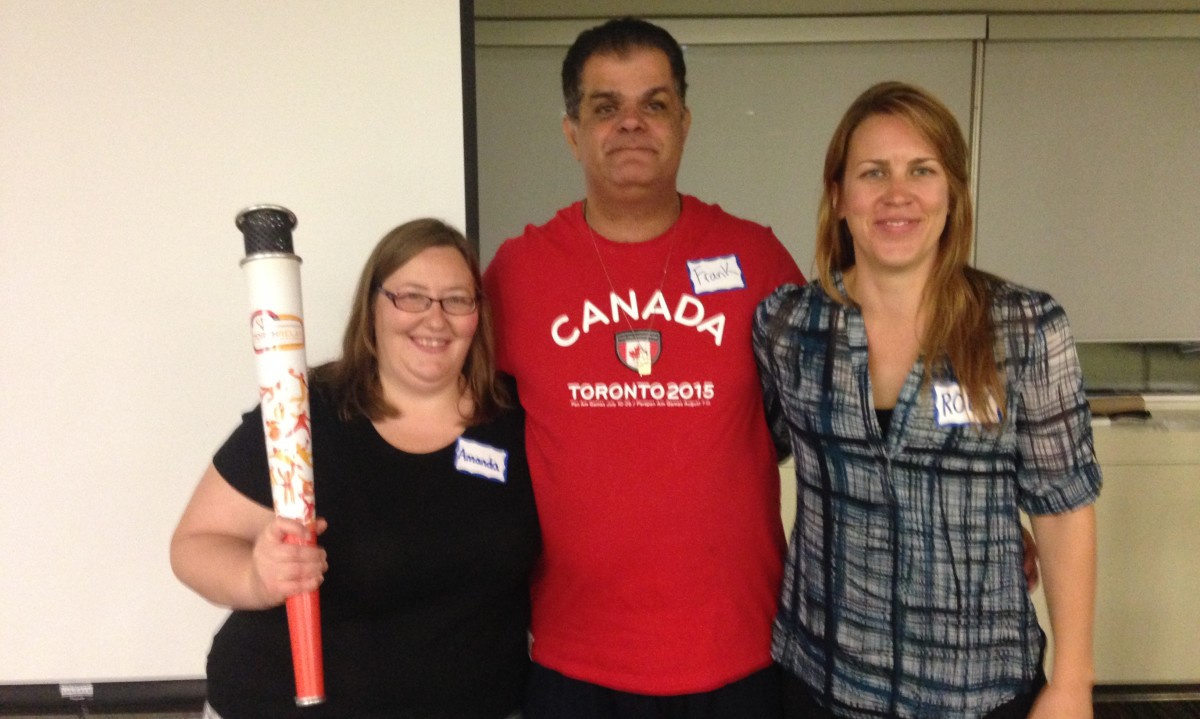
At our September community meeting, Amanda Muise and Roby Miller from Community Head Injury Resource Services (CHIRS) gave a presentation about positive psychology.
We also had the opportunity to hear our long-time member Frank Bruno talk about running the Pan Am Relay this past June, and many of us posed with his relay torch (see below.)

Positive psychology is a relatively new field of psychology, developed by Martin Seligman, the former president of the American Psychological Association. Seligman was motivated by wanting to know what makes people happier on a daily basis.
Seligman found that the roots of happiness are:
- having positive emotions
- being engaged in an activity or profession you love and can ‘get lost’ in
- being in positive relationships
- having meaning in your life (giving of yourself to others)
- having a sense of achievement in your activities
And while it is kind of obvious, but also worthwhile mentioning, happiness is important because it’s good for you. People who are happy have fewer heart attacks, strokes and tend to live longer.
Other keys to finding happiness include:
- the ability to savour – not chugging your coffee, but enjoying it
- gratitude – being grateful for everything you have
- having a positive attitude
- mindfulness
Amanda and Roby gave us some exercises to help increase happiness.
Write a letter:
Take a moment to think of someone who made a big impact on your life. This person could be a teacher who helped you pass a difficult class, or an important friend in your life. Write a short letter to that person and explain the impact they had on you. You don’t have to share the letter, or even tell the person about it, though research shows that sharing this with the person increases your happiness.
‘Trick’ your brain into being happy
Body language can have a big impact on your brain. As social psychologist Amy Cuddy discusses in her Ted Talk, standing like Super Man in front of the mirror actually boosts your self-confidence. Chewing on a clean pencil uses the same muscles as smiling, and can actually make you feel happier, because your brain thinks you’re actually smiling.
Practise mindfulness
It’s easier said than done, but learning how to pay attention to the present moment or purposely slowing things down can increase your happiness. Even taking just one minute to meditate can be very helpful.
Take a moment to think about your day
This daily practise can help with gratitude and mindfulness:
Take a moment to think about your day.
Record something that went well: what was the event? What had to happen for it go well? Why did it go well? What role did you play? Why is it important?
Find your 24 strengths
Learning about your strengths and how to use them is crucial to leading a happy life. You can take about 10 minutes and learn about your 24 top strengths at the VIA Institute on Character, a non-profit psychology organization. You’ll need to sign into the site, but it’s free. Another great resource is authentichappiness.org

You can find out more about positive psychology by reading Sophia Voumvakis’ post on Finding Happiness after ABI, here. And we wrote about Frank’s Pan Am Relay experience this summer, right here.
There are a lot of meditation apps you can use, including some which are specific for brain injury. We’ve also discussed mindfulness at other community meetings, which you can read about here.
NEXT COMMUNITY MEETING: MONDAY, OCTOBER 26th
TOPIC: TECHNOLOGY AND ABI
Filed under: Community Meetings, Mental Health, Mindfulness Tagged: Amanda Muise, Amy Cuddy, CHIRS, community meeting, Frank Bruno, Martin Seligman, mindfulness, Pan Am Relay, positive psychology, Robi Miller, Ted Talk
![]()





